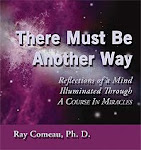I am just
loving Jon Mundy’s new book, entitled “A Course in Miracles and. . .”
In the Introduction he makes clear his
intention:
It is the intention of this book to
show how many of the ideas contained in A Course in Miracles are reflected in a
host of different religions, individual thinkers and schools of thought which
both pre-dated the printing of the Course and can now be found in the teaching
of other contemporary teachers.
In the 32
Chapters, you will find comparisons with The Bhagavad Gita, Yoga, Buddhism,
Judaism, Alcoholics Anonymous, and so forth.
One of the
first Chapters I read was Jon’s, “After Enlightenment, Zen What?”
This section
of his Chapter, “Make Believe” caught my eye:
In 1958, Country Music Singer, Conway
Twitty (1933-1993) had a number one hit song entitled, “Make Believe,” in which
he bemoaned the fact that all the hopes and dreams he had about a possible
loving relationship were—only make-believe.
“My only prayer will be. . .someday you’ll care for me, but it’s o o only
make believe.” Zen says, “Be in the world but don’t be of the world.” Don’t be caught in make-believe. There is no need to renounce the world—just see
its illusory nature and let it be. That
which needs to be fixed isn’t in the world—it’s in the mind. Thus, Mahatma Gandhi can say, “Be the change
you want to see.”
It is obvious
to me that Conway Twitty, the narrator of the song, recognizes that he is
experiencing only “make believe,” and, yet, he does not see the alternative; he
does not see that it is possible to shift from a special relationship to a holy
relationship.
This morning,
after reading that Chapter yesterday I, synchronistically, read these two
stanzas in Chapter 30, “The New Beginning,” Section Viii, “Changeless Reality.” In these stanzas, you will see that I played
with the pronouns and added some parenthetical comments, as if I were talking
with Conway Twitty.
Because reality is
changeless is
a miracle already there to heal
all things that change, and offer them
to you
to see in happy form, devoid of fear.
It will be given you to look upon
your sister thus. But not while you would have
it otherwise in some respects. (make believe) For this
but means you would not have her healed and whole.
The Christ in her is perfect. Is it this
that you would look upon? Then let
there be
no dreams (make believe) about her
that you would prefer
to seeing this. (holiness) And you will see the Christ
in her
because you let Him come to you.
And when He has appeared to you, you
will
be certain you are like Him, for He is
the changeless in your sister and in you.
This will you look upon when you
decide
there is not one appearance you would
hold
in place of what your sister really is.
Let no temptation to prefer a dream (make believe)
allow uncertainty to enter here.
Be not made guilty and afraid when you
are tempted by a dream (make believe) of what she is.
But do not give it power to replace
the changeless in her in your sight of her.
There is no false appearance but will
fade,
if you request a miracle instead.
There is no pain from which she is not free,
if you would have her be but what she is.
Why should you fear to see the Christ
in her?
You but behold yourself in what you
see.
As she
is healed are you made free of guilt,
for her appearance is your own to you.
(5,6)
(5,6)
The Course and many other spiritual
teachings show us how to make this shift.
